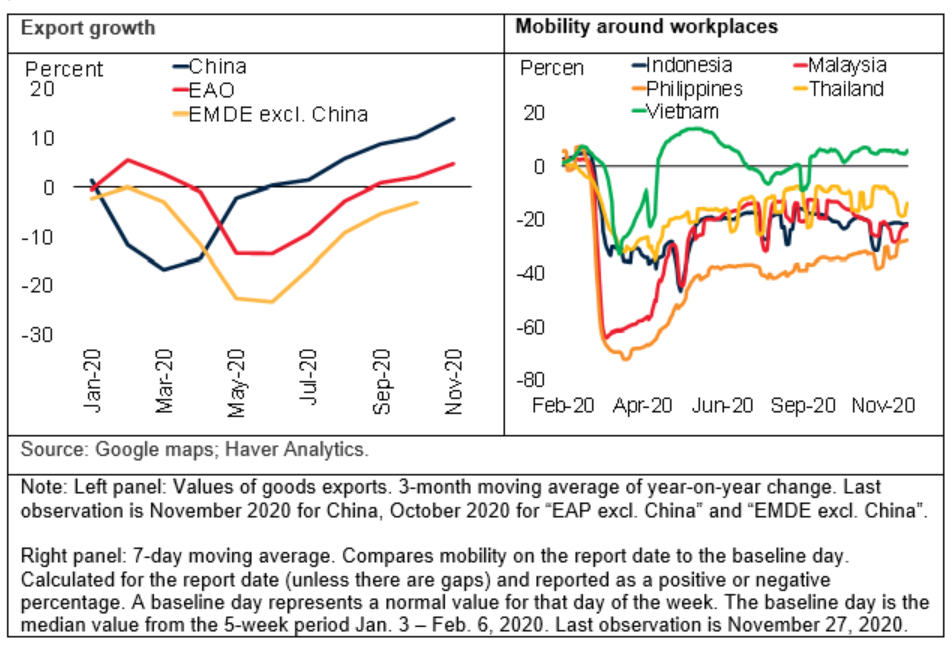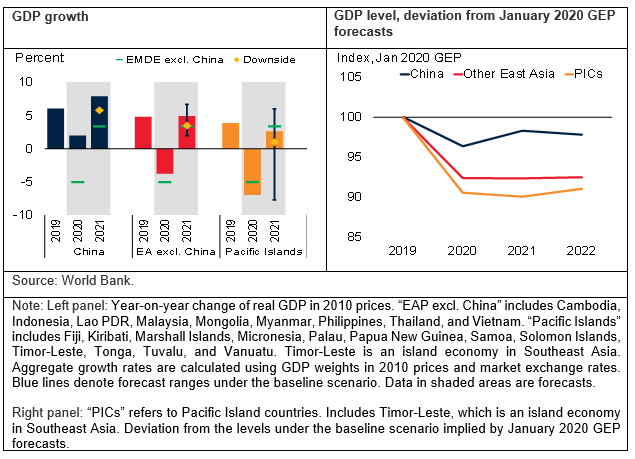 戴着防护面罩的超市收银员。(图片来源:pixfly/Shutterstock)
戴着防护面罩的超市收银员。(图片来源:pixfly/Shutterstock)
After a sharp slowdown to 0.9 percent in 2020, output in East Asia and Pacific (EAP) is projected to expand 7.4 percent in 2021, to a level still around 3 percent below pre-pandemic projections. While China is expected to recover strongly, the level of output in the rest of EAP is expected to remain around 7.5 percent below pre-pandemic projections in 2022, with significant cross-country differences. The pandemic is expected to leave lasting economic scars on the region and dampen potential growth and incomes. Key downside risks to the outlook include the possibility of renewed outbreaks and delayed rollout of a vaccine; heightened financial stress amplified by elevated debt levels; and the possibility of more severe and longer-lasting effects from the pandemic, including persistent policy uncertainty and subdued investment.
1. Following a collapse in 2020 Q1, China’s output has quickly rebounded.
In China, which has kept new infections at a low rate, GDP is estimated to have expanded by 2 percent in 2020—about 4 percent below potential. Activity has been supported by a quick and sustained resumption of production and exports and additional boosts from stimulus-fueled public investment.
2. The rest of the region suffered significant output losses in 2020, with significant cross-country differences.
GDP in the region excluding China contracted by 4.3 percent, and growth in about two-thirds of the regional economies declining by more than 7 percentage points below their long-term average. Activity has been supported by a quick and sustained resumption of production and exports, with additional boosts from stimulus-fueled public investment. The worst-hit economies were those with extended periods of lockdowns combined with large domestic outbreaks (the Philippines) or domestic policy uncertainty (Malaysia, Thailand, Timor-Leste), and those with a heavy reliance on tourism and travel (Fiji, Thailand, Palau, Vanuatu). Country-specific factors, including natural disasters—tropical cyclone Harold in Fiji and severe drought in Thailand—compounded the negative impact of the pandemic. Vietnam, which has kept new infections at a low rate, GDP is estimated to have expanded by 2.8 percent.
3. Restrictions on economic activity to stem the pandemic have largely eased across the region, and goods exports have started to recover.
Although the spread of the pandemic appears to have slowed in much of the region, infection rates remain elevated in Indonesia and the Philippines and have been increasing recently in Malaysia. In Myanmar, higher infection rates and new lockdowns are leading to severe increases in poverty and food security. Without an effective medical treatment or vaccination, mobility continues to be limited by remaining social distancing measures and travel restrictions. Such restrictions, along with significant income and job losses, have weakened consumer confidence, and lingering policy uncertainty continues to weigh on private spending.
4. Regional growth is projected to accelerate to 7.4 percent in 2021, led by a strong rebound in China.
In the rest of the region, the recovery is expected to be more protracted. Following last year’s contraction, output in the region excluding China is expected to expand by 4.9 percent in 2021 and 5.2 percent in 2022, to a level around 7.5 percent below pre-pandemic projections, with significant cross-country variations. Vietnam was able to control the pandemic at modest human and economic costs and its exports have remained resilient despite global headwinds. The country is projected to suffer an output loss of around 4 percent compared to pre-pandemic projections by 2022. In contrast, Pacific Island countries have been largely spared by the pandemic but have been devastated by the collapse in global tourism and travel. These economies are expected to remain around 9 percent below their pre-pandemic projected level. The cumulative output loss over 2020-22 is estimated to be around ten percent of its 2019 level. Risks are amplified by existing vulnerabilities, including high and rising public and private debt levels.
Read more
-
Report: Global Economic Prospects (January 2021)
-
Feature story: A Subdued Recovery, with Damage to Undo






Join the Conversation